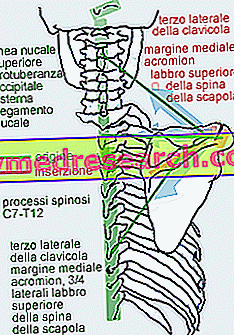
The trapezius muscle is located in the nuchal region and in the dorsal part of the thorax. It is commonly divided into three parts: descending, transverse and ascending.
The descending part originates from the superior nuchal line, from the external occipital protuberance and from the nuchal ligament. The transverse part originates from the spinous process of the 7th cervical vertebra to the spinous process of the 3rd thoracic vertebra. The ascending part originates from the spinous process of the 2-3th thoracic vertebra to the spinous process of the 12th thoracic vertebra.
The descending part is inserted at the lateral third of the clavicle, the transverse part at the medial margin of the acromion and the ascending part at the superior lateral margin of the spine of the scapula
With its action it elevates and gives the shoulder, extends the head by rotating it towards the opposite side. Draw back the scapula and collarbone. The descending part participates with the gran dentato muscle in raising the scapula (forced inspiration). It also has a static function by supporting the scapula by estab- lishing the shoulder joint. It is important in lifting and transporting heavy loads as it prevents the scapula from falling due to weight action.
It allows abduction of the scapula from 90 ° to 150 ° by working with the large dentate muscle. Up to 90 ° the movement is performed by the deltoid muscle with the participation of the supraspinatus. At 150 ° the abduction movement stops due to the antagonist intervention of the large dorsal and the pectoralis major. To reach 180 ° the spine participates in the movement by tilting and / or increasing lumbar lordosis.
A similar argument can be made for the flexion of the arm where the trapezium, in synergy with the large toothed muscle, allows elevation from about 60 to 120 °. From 0 ° to 60 ° the deltoid, coraco-brachial and pectoralis (clavicular part) muscles intervene in the flexion. To overcome the 120 ° and reach the maximum flexion (180 °) the rachis intervenes inclining and / or increasing the lumbar lordosis.
It is innervated by the accessory nerve (11th encephalic nerve) and branches of the cervical plexus (C2-C4)
ORIGIN Descending part: upper nuchal line; external occipital protuberance; nuchal ligament; Transverse part: from the spinous process of the 7th cervical vertebra to the spinous process of the 3rd thoracic vertebra Ascending part: from the spinous process of the 2-3th thoracic vertebra to the spinous process of the 12th thoracic vertebra |  |
| INSERTION lateral third of the clavicle, medial margin acromion, 3/4 lateral upper lip of the spine of the scapula | |
| ACTION Intervenes in the forced inspiration; the scapula elevates, adducts and rotates externally; extends, rotates, tilts the head and the cervical spine laterally | |
| INNERVATION Accessory nerve (11th encephalic nerve) and branches of the cervical plexus (C2-C4) |
| Upper limb | Lower limb | Trunk | Abdomen | Articles |



